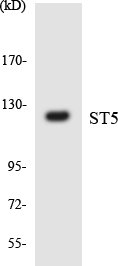ST5 Polyclonal Antibody
- Catalog No.:YT4432
- Applications:WB;ELISA
- Reactivity:Human;Mouse
- Target:
- ST5
- Gene Name:
- ST5
- Protein Name:
- Suppression of tumorigenicity 5 protein
- Human Gene Id:
- 6764
- Human Swiss Prot No:
- P78524
- Mouse Gene Id:
- 76954
- Mouse Swiss Prot No:
- Q924W7
- Immunogen:
- The antiserum was produced against synthesized peptide derived from human ST5. AA range:411-460
- Specificity:
- ST5 Polyclonal Antibody detects endogenous levels of ST5 protein.
- Formulation:
- Liquid in PBS containing 50% glycerol, 0.5% BSA and 0.02% sodium azide.
- Source:
- Polyclonal, Rabbit,IgG
- Dilution:
- WB 1:500 - 1:2000. ELISA: 1:20000. Not yet tested in other applications.
- Purification:
- The antibody was affinity-purified from rabbit antiserum by affinity-chromatography using epitope-specific immunogen.
- Concentration:
- 1 mg/ml
- Storage Stability:
- -15°C to -25°C/1 year(Do not lower than -25°C)
- Other Name:
- ST5;DENND2B;HTS1;Suppression of tumorigenicity 5 protein;DENN domain-containing protein 2B;HeLa tumor suppression 1
- Observed Band(KD):
- 126kD
- Background:
- This gene was identified by its ability to suppress the tumorigenicity of Hela cells in nude mice. The protein encoded by this gene contains a C-terminal region that shares similarity with the Rab 3 family of small GTP binding proteins. This protein preferentially binds to the SH3 domain of c-Abl kinase, and acts as a regulator of MAPK1/ERK2 kinase, which may contribute to its ability to reduce the tumorigenic phenotype in cells. Three alternatively spliced transcript variants of this gene encoding distinct isoforms are identified. [provided by RefSeq, Jul 2008],
- Function:
- function:May be involved in cytoskeletal organization and tumorgenicity. Isoform 1 seems to be involved in a signaling transduction pathway leading to activation of MAPK1/ERK2. Isoform 3 may block ERK2 activation stimulated by ABL1. Isoform 3 may alter cell morphology and cell growth.,similarity:Contains 1 dDENN domain.,similarity:Contains 1 DENN domain.,similarity:Contains 1 uDENN domain.,subunit:Isoform 1 interacts with the SH3 domain of ABL1.,tissue specificity:Widely expressed with the exception of peripheral blood lymphocytes. Isoform 1 is expressed in several epithelial and fibroblast (including tumorigenic) but absent in lymphoid cell lines (at protein level). Isoform 3 is expressed in primary cell or weakly tumorigenic but not in tumorigenic cell lines (at protein level).,
- Subcellular Location:
- [Isoform 1]: Cytoplasm, cell cortex . Cell membrane . Recycling endosome . Colocalizes with RAB13 and ITSN1 at cytoplasmic vesicles that are most likely recycling endosomes. Colocalizes with the cortical actin cytoskeleton. .
- Expression:
- Widely expressed with the exception of peripheral blood lymphocytes. Isoform 1 is expressed in several epithelial and fibroblast (including tumorigenic) but absent in lymphoid cell lines (at protein level). Isoform 3 is expressed in primary cell or weakly tumorigenic but not in tumorigenic cell lines (at protein level).
- June 19-2018
- WESTERN IMMUNOBLOTTING PROTOCOL
- June 19-2018
- IMMUNOHISTOCHEMISTRY-PARAFFIN PROTOCOL
- June 19-2018
- IMMUNOFLUORESCENCE PROTOCOL
- September 08-2020
- FLOW-CYTOMEYRT-PROTOCOL
- May 20-2022
- Cell-Based ELISA│解您多样本WB检测之困扰
- July 13-2018
- CELL-BASED-ELISA-PROTOCOL-FOR-ACETYL-PROTEIN
- July 13-2018
- CELL-BASED-ELISA-PROTOCOL-FOR-PHOSPHO-PROTEIN
- July 13-2018
- Antibody-FAQs
- Products Images

- Western Blot analysis of various cells using ST5 Polyclonal Antibody
.jpg)
- Western Blot analysis of COLO205 cells using ST5 Polyclonal Antibody

- Western blot analysis of lysates from COLO205 cells, using ST5 Antibody. The lane on the right is blocked with the synthesized peptide.

- Western blot analysis of the lysates from COLO205 cells using ST5 antibody.


